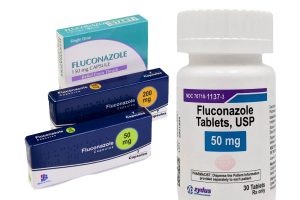Pink eye is commonly called conjunctivitis infection, which describes the inflammation of the lining of the eye surface and eyelids (called “conjunctiva”). The infection is characterized by the redness of the eyes that is often accompanied by swelling, itching, and discharge. Although it comes from various sources, some forms of conjunctivitis are viral, so you can use antibiotics to treat the condition. In this article, we’ll take a closer look at pink eye antibiotics, so you can learn more about the best way to treat them.
Common Pink Eye Antibiotics
Conjunctivitis is an inflammatory condition that can arise due to various causative agents, including bacterial or viral infections.
While conjunctivitis will go away on its own within 7 to 10 days, your doctor might prescribe a topical antibiotic eye drop to speed up the healing in the case of a bacterial infection.
The most common pink eye antibiotics are:
- Ciprofloxacin
- Ofloxacin
- Erythromycin
- Tobramycin
- Moxifloxacin
- Chloramphenicol
- Doxycycline
Remember that antibiotics aren’t always prescribed because they’re ineffective for conjunctivitis caused by viruses.
Additionally, you might use other treatments and home remedies in the case of chemical and allergic conjunctivitis, such as:
- Antihistamines and artificial tears to reduce the itching and irritation of the eyes
- Applying cold compress against the eyes (the compress must also be clean)
- Avoid using or sharing personal items with others, such as towels, contact lenses, makeup, sunglasses, etc.
Pink Eye Antibiotic Drops
Many antibiotic drops on the market effectively treat bacterial conjunctivitis. Among the most popular brand names are:
- Ciloxan (ciprofloxacin)
- Tobrex, Tobrasol, Tomycine, and Tobralcon (tobramycin)
- Eyemycin, Ilotycin, and Romycin (erythromycin)
Each antibiotic eye drop is taken several times daily for a specific period, usually around 3 to 7 days.
You should expect the associated symptoms to clear up within 24 to 36 hours of the first treatment dose. Yet, you must keep taking the medication for the prescribed period to prevent the condition from returning.
How Long Antibiotics Take To Work For Conjunctivitis?
According to a randomized clinical trial to study the effect of antibiotics on the duration of conjunctivitis infection, topical antibiotics show a considerable recovery rate at a shorter time when administered correctly.
You should expect the infection and symptoms to start clearing up within 24 to 36 hours of treatment. On the other hand, if you don’t use any antibiotics, you should expect similar results within 7 to 10 days of infection.
Remember that you’ll still need to continue using the antibiotics for the prescribed period to avoid relapsing.
Pink Eye Antibiotics for Toddlers
Since toddlers and children have a generally weaker immune system, conjunctivitis is quite common among them.
Like adults, the inflammation of the cornea can harm the toddler’s vision. While the condition usually eases on its own, complications can permanently damage the eyes. For that reason, many doctors would prescribe antibiotics in the case of bacterial infection to reduce the risk of adverse reactions and complications.
Antibiotics for conjunctivitis are usually available in the form of eye ointments and eye drops. The ointments are generally the preferred dosage form for children because they last longer and don’t wipe off easily. The doctor determines the dose of the antibiotic, but it’s essential to administer the treatment for the prescribed period.
In the case of viral conjunctivitis, doctors might recommend supportive treatments and cold compresses instead of antibiotics, as they’re primarily ineffective in that situation.
Antibiotics Side Effects
Like any medication, antibiotics for conjunctivitis might come with some side effects. Luckily, in the case of topical antibiotics, the side effects are usually less frequent and less severe.
While the exact side effects of a particular antibiotic might vary from one type to another, most side effects include the following:
- Slight eye discomfort or burning sensation
- Tearing
- Light sensitivity
- Dry eyes
Some doctors might also prescribe artificial tears and painkillers to reduce the impact of these side effects.
Oral Antibiotics for Conjunctivitis
Most doctors will prescribe a topical antibiotic for pink eye in the form of eye drops or ointments. This is because topical treatments help clear the medication faster with fewer side effects.
Suppose the bacterial infection is intense or the patient’s immune system is compromised. Doctors might also prescribe an oral antibiotic, usually ciprofloxacin or amoxicillin, to help with the treatment. Your doctor will usually perform a few tests before prescribing antibiotics because they’re ineffective in the case of viral pink eye.
Over-the-Counter Pink Eye Antibiotics
Over-the-counter medications are any treatments you can buy and use directly without needing a prescription from a professional healthcare provider. The laws for OTC medications vary from one country to another, so it highly depends on where you live.
The vast majority of antibiotics used for treating bacterial conjunctivitis in the U.S. are only available through a prescription.
Other OTC medications will alleviate bacterial, viral, and even chemical conjunctivitis symptoms, such as artificial tears, oral antihistamines, and NSAIDs like ibuprofen.

Frequently Asked Questions (FAQs)
There are various antibiotics that you can use to treat pink eye. However, studies have shown that many popular antibiotics are almost equally effective in treating the condition, so there isn’t a particular best antibiotic for this infection.
However, the most commonly prescribed antibiotics for treating pink eye are Ciprofloxacin, Ofloxacin, Erythromycin, and Tobramycin, as they’re highly effective and available in various forms. Keep in mind that even the best antibiotics for conjunctivitis won’t be effective in the case of conjunctivitis caused by a virus.
In the conjunctivitis caused by bacteria, you should expect antibiotics to show a significant improvement in a very short time (compared to not taking medications).
Ideally, your eyes should start clearing up in as little as 12 to 24 hours in the case of a mild infection, but make sure that you continue using the medication for the prescribed period so that the infection doesn’t return.
Amoxicillin is a potent broad-spectrum antibiotic. While it’s highly effective against all kinds of bacteria that cause conjunctivitis, most doctors will recommend using topical alternatives instead, such as Ciprofloxacin and Tobramycin.
However, in the case of a severe internal infection or high-risk patients with a compromised immune system, doctors might prescribe a systemic oral antibiotic along with the topical treatment to speed up the recovery.
An antibiotic is highly effective at treating infectious conjunctivitis of bacterial origin and helps alleviate the symptoms within 24 hours. However, you don’t necessarily have to take an antibiotic for treatment because, in most cases, your eyes will clear up on their own in about 5 to 10 days.
With that said, taking antibiotics for conjunctivitis can be necessary for patients with weaker immune systems and high-risk patients.
Oral antibiotics can help speed up the recovery of conjunctivitis, although not necessary if the topical antibiotic is quite effective.
Oral antibiotics also won’t work with virus-related conjunctivitis and might even prolong the symptoms, so they’re only prescribed when local antibiotics aren’t enough to treat conjunctivitis caused by bacteria.
Most antibiotics in the United States are only available through a prescription. The antibiotics available over the counter are only a few, such as Polymyxin, Bacitracin, and Pramoxine.
Bacitracin and polymyxin B combination is used as an ophthalmic eye drop to treat various bacterial infections of the conjunctiva and the cornea. However, these medications usually contain other prescription-only ingredients.
No OTC antibiotics can be used to treat bacterial or virus-related conjunctivitis. However, you can use OTC treatments to alleviate some of the symptoms. This includes using artificial tears to soothe the gritty sensation and itching of the eye.
The best antibiotic eye drops for eye care are the ones that contain Ciprofloxacin and Tobramycin. The most popular brand names for these medications in the U.S. are Ciloxan and Tobrex, respectively.
These medications are also available in the form of eye ointments, which are easier to apply for children.
Technically, you don’t need to see a doctor if you have conjunctivitis, as the condition usually eases on its own within a few days.
However, if the condition worsens or adverse symptoms accompany conjunctivitis, you should visit the eye doctor as soon as possible to get your eye treated.
These symptoms include:
- Noticeable pain or pressure buildup in the eyes
- Severe redness and swelling
- Blurred vision even after wiping discharge
- Sensitivity to light
Depending on the assessment of your health care provider, amoxicillin might be prescribed to treat an eye infection.
However, amoxicillin is only effective in treating bacterial infections and won’t speed up or improve a viral eye infection any sooner.
Regarding bacterial eye infections, the most popular antibiotics are Ciprofloxacin, Moxifloxacin, Chloramphenicol, Doxycycline, Tobramycin, and Erythromycin.
As for viral eye infections, antibiotics can be ineffective and may even prolong the treatment. However, you can still use supportive treatments and allow your eyes to clear up on their own.
In addition to redness in the eyes, conjunctivitis comes with various symptoms, including intense itching due to inflammation and the release of histamine.
In addition to antibiotics, Benadryl and other antihistamine eye drops can help soothe the itching sensation if you’re pink eye diagnosed.
This also helps you keep your hands off your eyes, which speeds up the recovery process and protects the eye from cross-contamination.
Like antibiotic eye drops, antibiotic eye ointments are also primarily available through prescriptions. However, this depends on the regulations of drugs where you live and the available treatments and medications over the counter.
This depends on the type of conjunctivitis in question. In the case of bacterial pink eye, antibiotics are highly effective in speeding up the treatment by eliminating the bacteria causing the infection. However, in the case of conjunctivitis caused by viruses, antibiotics can worsen the infection by prolonging its symptoms.
Neosporin ophthalmic solution and ointment contains Neomycin, Gramicidin, and Polymyxin B, all of which are antibiotics that can significantly help with inflammatory eye infections, such as conjunctivitis caused by bacteria. However, like other antibiotics, this one is only available through a prescription.
According to a study, alcohol does interact with several classes of antibiotics. So ideally, it’s best to avoid drinking while using antibiotics to prevent the risk of interactions and reduced effectiveness, even if there isn’t any warning listed on the medication about alcohol consumption.
Conclusion
As you can see, antibiotics are highly effective at speeding up recovery after infection, especially in the case of bacterial conjunctivitis according to the National Eye Institute. However, on the other hand, you can’t treat the viral and allergic pink eye with antibiotics.
Luckily, however, in most cases, the eyes should clear up within 7 to 10 days on their own, regardless of the source of infection.





